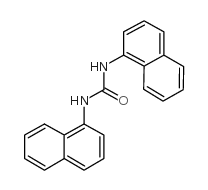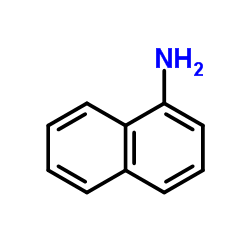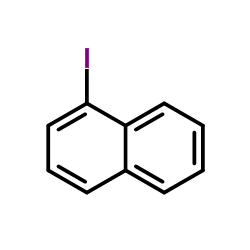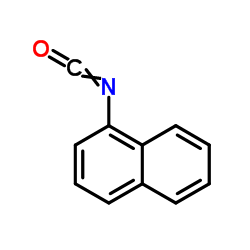Urea,N,N'-di-1-naphthalenyl-
Modify Date: 2025-08-25 19:50:11

Urea,N,N'-di-1-naphthalenyl- structure
|
Common Name | Urea,N,N'-di-1-naphthalenyl- | ||
|---|---|---|---|---|
| CAS Number | 607-56-7 | Molecular Weight | 312.36500 | |
| Density | 1.311g/cm3 | Boiling Point | 447.4ºC at 760 mmHg | |
| Molecular Formula | C21H16N2O | Melting Point | 285-298ºC | |
| MSDS | N/A | Flash Point | 151.9ºC | |
| Name | n,n'-di-(1-naphthyl)urea |
|---|---|
| Synonym | More Synonyms |
| Density | 1.311g/cm3 |
|---|---|
| Boiling Point | 447.4ºC at 760 mmHg |
| Melting Point | 285-298ºC |
| Molecular Formula | C21H16N2O |
| Molecular Weight | 312.36500 |
| Flash Point | 151.9ºC |
| Exact Mass | 312.12600 |
| PSA | 41.13000 |
| LogP | 5.78300 |
| Index of Refraction | 1.789 |
| InChIKey | OAXACVUBJMHKTD-UHFFFAOYSA-N |
| SMILES | O=C(Nc1cccc2ccccc12)Nc1cccc2ccccc12 |
Synonym: Section 2 - COMPOSITION, INFORMATION ON INGREDIENTS
Risk Phrases: None Listed. Section 3 - HAZARDS IDENTIFICATION EMERGENCY OVERVIEW
Not available. Potential Health Effects Eye: May cause eye irritation. Skin: May cause skin irritation. May be harmful if absorbed through the skin. Ingestion: May cause irritation of the digestive tract. May be harmful if swallowed. Inhalation: May cause respiratory tract irritation. May be harmful if inhaled. Chronic: Not available. Section 4 - FIRST AID MEASURES Eyes: Flush eyes with plenty of water for at least 15 minutes, occasionally lifting the upper and lower eyelids. Get medical aid. Skin: Get medical aid. Flush skin with plenty of water for at least 15 minutes while removing contaminated clothing and shoes. Ingestion: Get medical aid. Wash mouth out with water. Inhalation: Remove from exposure and move to fresh air immediately. Notes to Physician: Treat symptomatically and supportively. Section 5 - FIRE FIGHTING MEASURES General Information: As in any fire, wear a self-contained breathing apparatus in pressure-demand, MSHA/NIOSH (approved or equivalent), and full protective gear. Extinguishing Media: Use water spray, dry chemical, carbon dioxide, or chemical foam. Section 6 - ACCIDENTAL RELEASE MEASURES General Information: Use proper personal protective equipment as indicated in Section 8. Spills/Leaks: Vacuum or sweep up material and place into a suitable disposal container. Section 7 - HANDLING and STORAGE Handling: Avoid breathing dust, vapor, mist, or gas. Avoid contact with skin and eyes. Storage: Store in a cool, dry place. Store in a tightly closed container. Section 8 - EXPOSURE CONTROLS, PERSONAL PROTECTION Engineering Controls: Use adequate ventilation to keep airborne concentrations low. Exposure Limits CAS# 607-56-7: Personal Protective Equipment Eyes: Not available. Skin: Wear appropriate protective gloves to prevent skin exposure. Clothing: Wear appropriate protective clothing to prevent skin exposure. Respirators: Follow the OSHA respirator regulations found in 29 CFR 1910.134 or European Standard EN 149. Use a NIOSH/MSHA or European Standard EN 149 approved respirator if exposure limits are exceeded or if irritation or other symptoms are experienced. Section 9 - PHYSICAL AND CHEMICAL PROPERTIES Physical State: Powder Color: white - grey Odor: Not available. pH: Not available. Vapor Pressure: Not available. Viscosity: Not available. Boiling Point: Not available. Freezing/Melting Point: 285 - 298 deg C Autoignition Temperature: Not available. Flash Point: Not available. Explosion Limits, lower: Not available. Explosion Limits, upper: Not available. Decomposition Temperature: Solubility in water: Insoluble. Specific Gravity/Density: Molecular Formula: C21H16N2O Molecular Weight: 312.37 Section 10 - STABILITY AND REACTIVITY Chemical Stability: Stable under normal temperatures and pressures. Conditions to Avoid: Incompatible materials. Incompatibilities with Other Materials: Strong oxidizing agents. Hazardous Decomposition Products: Nitrogen oxides, carbon monoxide, carbon dioxide. Hazardous Polymerization: Will not occur. Section 11 - TOXICOLOGICAL INFORMATION RTECS#: CAS# 607-56-7 unlisted. LD50/LC50: Not available. Carcinogenicity: N,N'-Di-(1-naphthyl)urea - Not listed by ACGIH, IARC, or NTP. Section 12 - ECOLOGICAL INFORMATION Section 13 - DISPOSAL CONSIDERATIONS Dispose of in a manner consistent with federal, state, and local regulations. Section 14 - TRANSPORT INFORMATION IATA No information available. IMO No information available. RID/ADR No information available. Section 15 - REGULATORY INFORMATION European/International Regulations European Labeling in Accordance with EC Directives Hazard Symbols: Not available. Risk Phrases: Safety Phrases: S 24/25 Avoid contact with skin and eyes. WGK (Water Danger/Protection) CAS# 607-56-7: No information available. Canada CAS# 607-56-7 is listed on Canada's NDSL List. CAS# 607-56-7 is not listed on Canada's Ingredient Disclosure List. US FEDERAL TSCA CAS# 607-56-7 is listed on the TSCA inventory. SECTION 16 - ADDITIONAL INFORMATION N/A |
| Precursor 9 | |
|---|---|
| DownStream 2 | |
| HS Code | 2924299090 |
|---|---|
| Summary | 2924299090. other cyclic amides (including cyclic carbamates) and their derivatives; salts thereof. VAT:17.0%. Tax rebate rate:13.0%. . MFN tariff:6.5%. General tariff:30.0% |
| N,N'-Bis(1-naphthalenyl)urea |
| di-1-naphthylurea |
| MFCD00390017 |
| N.N'-Di- |
| N,N'-Di-[1]naphthyl-harnstoff |
 CAS#:134-32-7
CAS#:134-32-7 CAS#:57-13-6
CAS#:57-13-6 CAS#:201230-82-2
CAS#:201230-82-2 CAS#:90-14-2
CAS#:90-14-2 CAS#:124-38-9
CAS#:124-38-9 CAS#:86-84-0
CAS#:86-84-0![3-[(E)-3-(4-bromophenyl)prop-2-enoyl]-4,6-dimethyl-1H-pyridin-2-one Structure](https://image.chemsrc.com/caspic/066/5255-68-5.png) CAS#:5255-68-5
CAS#:5255-68-5 CAS#:6620-41-3
CAS#:6620-41-3 CAS#:32315-10-9
CAS#:32315-10-9 CAS#:74470-80-7
CAS#:74470-80-7